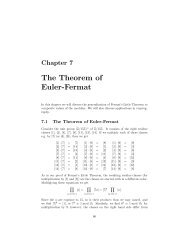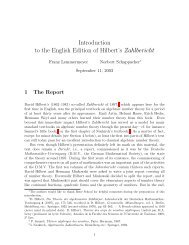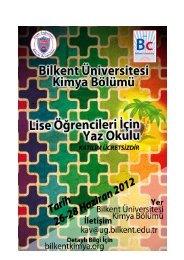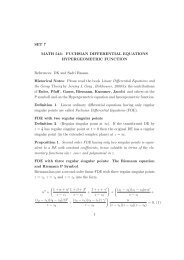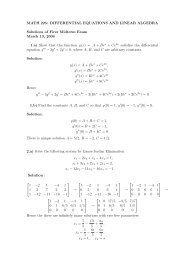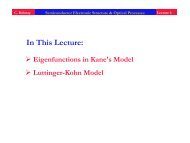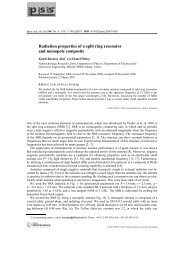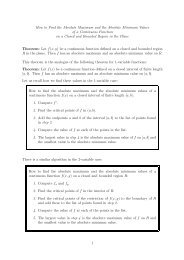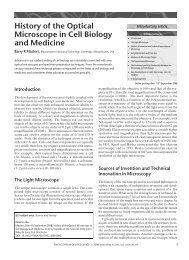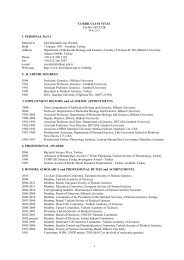Correlation of histology and linear and nonlinear microscopy of the ...
Correlation of histology and linear and nonlinear microscopy of the ...
Correlation of histology and linear and nonlinear microscopy of the ...
You also want an ePaper? Increase the reach of your titles
YUMPU automatically turns print PDFs into web optimized ePapers that Google loves.
Journal <strong>of</strong><br />
BIOPHOTONICS<br />
132<br />
B. R. Masters: <strong>Correlation</strong> <strong>of</strong> <strong>histology</strong> <strong>and</strong> <strong>linear</strong> <strong>and</strong> non<strong>linear</strong> <strong>microscopy</strong> <strong>of</strong> <strong>the</strong> living human cornea<br />
Figure 1 Confocal <strong>microscopy</strong> <strong>of</strong> <strong>the</strong> cornea immediately<br />
following overnight lid closure. Corneal micro-folds are<br />
observed in <strong>the</strong> full thickness <strong>of</strong> <strong>the</strong> stroma: (A) anterior<br />
stroma, (B) midstroma, <strong>and</strong> (C) posterior stroma. The microscope<br />
objective has a magnification <strong>of</strong> 50 . Scale<br />
Bar ¼ 50 mm.<br />
immediately following this condition suggests that<br />
<strong>the</strong>ir origin is related to this condition. Overnight lid<br />
closure results in <strong>the</strong> formation <strong>of</strong> micro-folds in <strong>the</strong><br />
stroma.<br />
It is postulated that cyclic process <strong>of</strong> corneal<br />
thickening over <strong>the</strong> period <strong>of</strong> sleep with <strong>the</strong> conco-<br />
mitant formation <strong>of</strong> micro-folds in <strong>the</strong> stroma, presumably<br />
due to <strong>the</strong> corneal thickening, <strong>and</strong> <strong>the</strong> reversal<br />
<strong>of</strong> <strong>the</strong> corneal thickening <strong>and</strong> <strong>the</strong> removal <strong>of</strong><br />
<strong>the</strong> folds in <strong>the</strong> stroma may present <strong>the</strong> cornea with<br />
<strong>the</strong> daily mechanical insult or stress.<br />
If <strong>the</strong> subject resumed normal blinking <strong>and</strong> <strong>the</strong>n<br />
after 30 minutes came to <strong>the</strong> eye clinic for <strong>the</strong> confocal<br />
eye examination <strong>and</strong> <strong>the</strong> measurements <strong>of</strong> corneal<br />
thickness with OLCR <strong>the</strong> transient morphological<br />
changes in <strong>the</strong> stroma would have been missed.<br />
Again, <strong>the</strong> correct experimental protocol is critical<br />
for human studies.<br />
This study demonstrates <strong>the</strong> correlation between<br />
<strong>the</strong> temporal course <strong>of</strong> <strong>the</strong> overnight corneal swelling<br />
<strong>and</strong> <strong>the</strong> appearance <strong>of</strong> folds in <strong>the</strong> stroma, <strong>and</strong><br />
<strong>the</strong> concomitant deswelling <strong>and</strong> loss <strong>of</strong> folds in <strong>the</strong><br />
stroma following lid opening <strong>and</strong> normal blinking, as<br />
observed with clinical confocal <strong>microscopy</strong> <strong>and</strong><br />
OLCR. Corneal thickness was measured to show <strong>the</strong><br />
temporal link (not causality) between <strong>the</strong> observations<br />
<strong>of</strong> <strong>the</strong> folds <strong>and</strong> <strong>the</strong> increased thickness <strong>of</strong> <strong>the</strong><br />
cornea. It is posited that <strong>the</strong> reduced oxygen concentration,<br />
changes lactate levels, results in corneal<br />
thickness increases, <strong>and</strong> <strong>the</strong>se thickness changes result<br />
in <strong>the</strong> observed micro-folds. It provides ano<strong>the</strong>r<br />
example <strong>of</strong> <strong>the</strong> limitations <strong>of</strong> confocal <strong>microscopy</strong><br />
applied to <strong>the</strong> human subject. If <strong>the</strong> confocal <strong>microscopy</strong><br />
was performed too late to observe <strong>the</strong> stromal<br />
folds, as explained in <strong>the</strong> previous paragraph, <strong>the</strong> results<br />
would be negative.<br />
2.4 O<strong>the</strong>r <strong>linear</strong> optical studies to study<br />
corneal function <strong>and</strong> morphology<br />
Ano<strong>the</strong>r optical technique to investigate tissue metabolism<br />
in <strong>the</strong> cornea is <strong>the</strong> measurement <strong>of</strong> <strong>the</strong> aut<strong>of</strong>luorescence<br />
<strong>of</strong> NAD(P)H [33, 34]. This field <strong>of</strong> cornea<br />
research was developed by Masters <strong>and</strong> Chance<br />
<strong>and</strong> has since emerged as a widespread technique to<br />
measure corneal cellular respiratory function [35].<br />
There are many confounding problems in both <strong>the</strong><br />
measurements <strong>and</strong> <strong>the</strong>ir interpretation <strong>and</strong> <strong>the</strong>y<br />
have been previously discussed [36]. In particular,<br />
<strong>the</strong>re is <strong>the</strong> problem <strong>of</strong> validation between <strong>the</strong> optical<br />
measurements <strong>of</strong> aut<strong>of</strong>luorescence <strong>and</strong> independent<br />
analytical studies <strong>of</strong> <strong>the</strong> cellular concentrations<br />
<strong>of</strong> <strong>the</strong> molecular concentrations that cause <strong>the</strong> aut<strong>of</strong>luorescence<br />
[37–39]. Ano<strong>the</strong>r confounding problem<br />
is that <strong>the</strong> cellular metabolism <strong>and</strong> <strong>the</strong> respiratory<br />
function <strong>of</strong> <strong>the</strong> various cell layers that comprise <strong>the</strong><br />
corneal epi<strong>the</strong>lium differ. Therefore, it is necessary<br />
to use an optical technique with <strong>the</strong> optical sectioning<br />
capability to image <strong>the</strong> aut<strong>of</strong>luorescence from<br />
each <strong>of</strong> <strong>the</strong> cell layers that form <strong>the</strong> epi<strong>the</strong>lium [40].<br />
Typically, this is not done in may investigations <strong>of</strong><br />
corneal aut<strong>of</strong>luorescence <strong>and</strong> that confounds <strong>the</strong> in-<br />
# 2009 by WILEY-VCH Verlag GmbH & Co. KGaA, Weinheim www.biophotonics-journal.org



